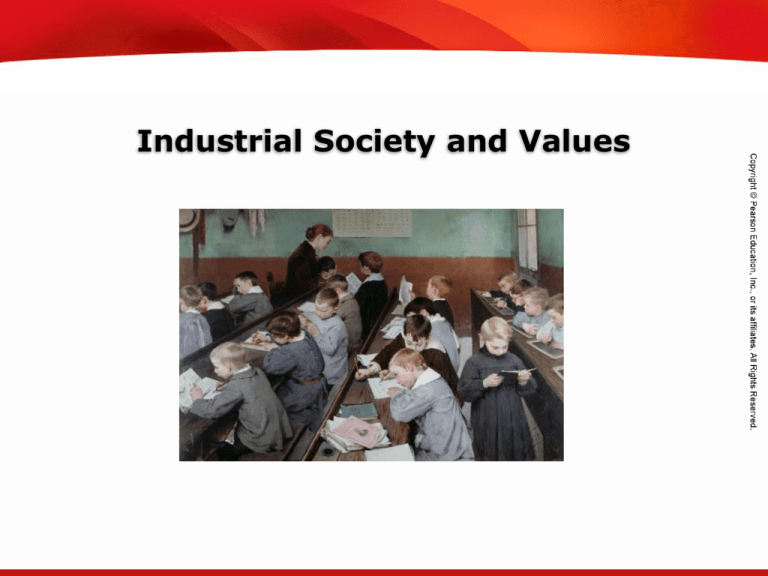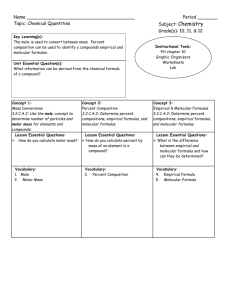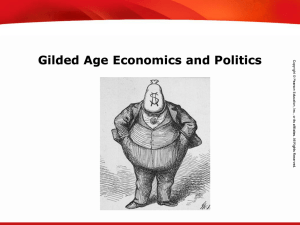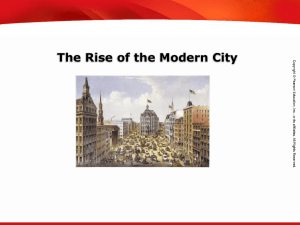Industrial Society and Values
advertisement

TEKS 8C: Calculate percent composition and empirical and molecular formulas. Industrial Society and Values TEKS 8C: Calculate percent composition and empirical and molecular formulas. Objectives • Explain the values that shaped the new social order. • Understand how women and educators sought change. • Learn how science challenged existing beliefs. TEKS 8C: Calculate percent composition and empirical and molecular formulas. Terms and People • cult of domesticity – a message put forth by books, magazines, and popular songs that idealized women and the home • temperance movement – a campaign to limit or ban the use of alcoholic beverages • Elizabeth Cady Stanton – a reformer who helped organize a movement for women’s rights • women’s suffrage – women’s right to vote TEKS 8C: Calculate percent composition and empirical and molecular formulas. Terms and People (continued) • Sojourner Truth – an African American suffragist • John Dalton – an English Quaker schoolteacher who developed modern atomic theory in the early 1800s, showing that each element has its own kind of atoms • Charles Darwin – the British naturalist who in 1859 published On the Origin of Species, in which he set forth the theory of evolution through natural selection TEKS 8C: Calculate percent composition and empirical and molecular formulas. Terms and People (continued) • racism – the belief that one racial group is superior to another • social gospel – a movement that urged Christians to social service TEKS 8C: Calculate percent composition and empirical and molecular formulas. How did the Industrial Revolution change the old social order and longheld traditions in the Western world? The Industrial Revolution brought challenges to the social order in the Western world. These challenges included demands for women’s rights, the rise of the middle class, and breakthroughs in science. TEKS 8C: Calculate percent composition and empirical and molecular formulas. Prior to the Industrial Revolution, there were only two main social classes: nobles and peasants. This changed in the 1800s. Three social classes emerged by the late 1800s. 1. The new upper class, a mix of aristocrats and wealthy entrepreneurs 2. The growing middle class and lower middle class 3. Workers and peasants TEKS 8C: Calculate percent composition and empirical and molecular formulas. As the middle class developed its own tastes and values, the role of women changed. • A code of etiquette guided behavior, childrearing, and dress. • Women had previously helped to run family businesses, but now men went off to work. • A cult of domesticity emerged, encouraging women to stay home. • This ideal rarely applied to the lower classes, in which women often worked outside the home. TEKS 8C: Calculate percent composition and empirical and molecular formulas. Some women worked to change the restrictions placed upon them. • They sought fairness in marriage, divorce, and property laws. • Many women’s groups also supported the temperance movement, viewing alcohol as a threat to the home. The struggle for political rights, including women’s suffrage, posed the biggest challenge. Elizabeth Cady Stanton and Sojourner Truth were two leaders of the movement in the United States. TEKS 8C: Calculate percent composition and empirical and molecular formulas. Industrialized societies needed educated, literate workers. • More governments set up public schools supported by taxes. • University education also expanded. • Some reformers sought greater educational opportunities for women. TEKS 8C: Calculate percent composition and empirical and molecular formulas. Scientists challenged long-held beliefs. Scientist Breakthrough John Dalton Showed that each element has its own kind of atoms. Charles Lyell Showed that the Earth had formed over millions of years. Charles Darwin In his book On the Origin of Species, explained how species could evolve through natural selection. TEKS 8C: Calculate percent composition and empirical and molecular formulas. Darwin’s theory of evolution grew out of observations he made while traveling on the HMS Beagle. Darwin’s ideas were controversial. Some church leaders argued that his theories contradicted the Bible. TEKS 8C: Calculate percent composition and empirical and molecular formulas. Some people used Darwin’s theory of natural selection to support their own beliefs about society. • Social Darwinists, for example, contended that industrial tycoons were more “fit” than those they put out of business. • Some argued that victory in war or business was proof of superiority, a view that encouraged racism. TEKS 8C: Calculate percent composition and empirical and molecular formulas. Religion continued to be a major force in society at this time. • Christian and Jewish organizations pushed for reforms to help the working poor. • Some churches opened schools. • Many Protestant churches promoted the social gospel, which urged Christians to social service.




